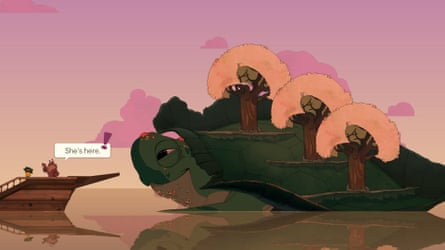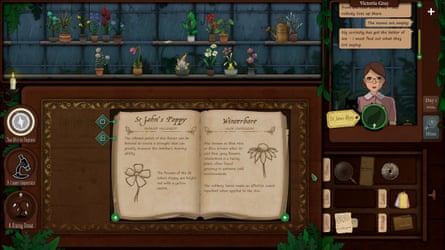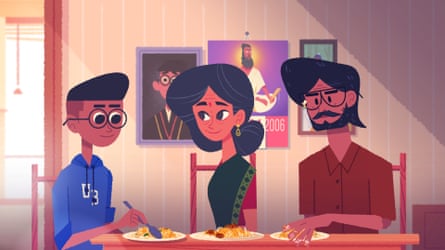In 2017, a game design thinktank called Project Horseshoe gathered a group of developers together to define the concept of cosiness in video games. Games, of course, have had non-violent elements since the medium was invented. Early life simulators such as 1985’s Little Computer People, a low-stakes game in which the player interacts with a man living his unremarkable life in a house, could fit the bill; then there was the proliferation of social farming simulations after 1996’s chibi-adorable Harvest Moon.
But the resulting report, Coziness in Games: An Exploration of Safety, Softness, and Satisfied Needs, is probably the first organised effort to define a then-emerging genre. The group zeroed in on three core things: safety, abundance, and softness. Cosy games (cozy in US spelling) don’t have high-risk scenarios: “There is no impending loss of threat,” they wrote. They must have a sense of abundance: “Nothing is lacking, pressing or imminent.” And a soft aesthetic wraps everything up like a warm hug.

Take developer Witch Beam’s puzzle game Unpacking, for example, which tells a story as the player takes things out of boxes and puts them into different houses. There are limitations to where you can put things: it’s a puzzle game, after all. But there’s no timer, no scoring system, no punishments for placing something wrong. And colorful pixel art brings it all together.
Project Horseshoe’s definition came alongside the launch of the Nintendo Switch in 2017, a handheld console designed to be cosied up with on the couch, and at that time the genre was experiencing huge growth. By 2019, indie game designer Matthew Taylor had started a Twitter account – called Wholesome Games – to highlight games that fitted the definition. Eventually, Wholesome Games (led by Taylor and partners Jenny Windom, James Tillman and Victoria Tran) grew into a community that hosted showcases full of cute and non-threatening games, and it has now become a company that publishes them.
The success of Wholesome Games mirrors the immense growth of the genre as a whole. The first Wholesome Direct was broadcast in 2020, as the cosy genre began to explode during the Covid-19 pandemic lockdowns (thanks in no small part to Nintendo’s chill island escape Animal Crossing: New Horizons), and had 25,000 viewers, Tillman claims. The most recent Wholesome Direct, which debuted in June, reached 5 million people.

You can see this trend on Steam, where more and more games are tagged with the “cozy” moniker. In 2020, just 15 games on Steam were released with the cozy tag attached, according to SteamDB. That number more than doubled in 2021, with 39 games, then doubled again in 2022, with 85. And then, the explosion: 373 games were tagged cozy in 2024 – more than one released per day on Steam. Every time the genre seems to have reached its peak, it rises higher. There are massive commercial hits, too: Animal Crossing sold nearly 50m, more than any game in the Call of Duty military shooter series. Famous farming game Stardew Valley, meanwhile, has sold 41m.
Kelly Boudreau, associate professor of game studies and design programme lead at Harrisburg University, says that cosy games aren’t just a genre, but an “ideological shift in game design – something that can be powerful in order to express different themes and play experiences.” You can see this in the diversity of experiences that cosy games offer. A Little to the Left and Unpacking are wildly different games about organising household items; A Short Hike is about a summer vacation stroll up a mountain; Spiritfarer is a comforting management simulator about death and grief, and Venba is an emotional story about nostalgia and cooking Tamil cuisine.

More recently, darker games have also been considered cosy: Strange Horticulture has the player running a shop selling – sometimes – poisonous plants, while Dredge adds a horror narrative on top of traditionally low-stakes fishing and sailing. “At the core of it, these games are joyful, hopeful, and compassionate,” says Wholesome Games partner Windom. “When people play them, we want them to feel a sense of warmth and a sense of safety. But that definition has expanded to include games that, perhaps, deal with uncomfortable or uncosy topics, but within the realm of safety.”
Rhea Gupte and Prateek Saxena of India-based imissmyfriends.studio did not set out to make a cosy game, but their debut, Fishbowl, is certainly one. Fishbowl stars Alo, a 21-year-old woman who’s just moved to a new city for a job as a video editor. Then the pandemic lockdowns begin, as she grieves the death of her grandmother. Despite the weighty topics, you can see the cosy everywhere in Fishbowl – in the meticulously designed colour palette, the intricate and detailed pixel art, and the soft, comforting sound design.

“We started off with the themes and the story and what we wanted to express,” writer and art director Gupte says. “Thinking about the design and overall feel of the game, it felt as if it needed a comforting atmosphere, otherwise it was going to become super heavy and difficult to play through. We wanted to have that sort of melancholy yet levity in the game.”
Cosy as a genre is evolving, and part of that is an understanding that cosy feels different for everyone. Still, not every non-violent game can be called cosy, Boudreau stresses: “It’s not valuable to stick that tag on everything, because it becomes meaningless.”

Fishbowl is not a cosy game in the way that Stardew Valley is, where players dream of an idyllic life on a farm. Gupte and Saxena spoke about the distance between how farming and agriculture are portrayed in games and what they are like in reality: “In India, agriculture is a very scary part of people’s lives,” Saxena said. “There’s a game from India called The Palace on the Hill, where the main character has to do farming to repay their debt. It’s a reverse cosy game. But in a different world, [farming] is considered a more laid-back life.”
Toem, a contemplative photography game released in 2021 by developer Something We Made, is another extension of the genre. Though it’s unequivocally a cosy game, it’s lacking something the genre is known for: a colour palette. Toem is rendered entirely in black and white. Monochrome can look harsh, Toem developer Lucas Gullbo says. But Toem isn’t harsh; the use of gradients and a soft aesthetic keeps the game from having “the emotional feeling of being black and white.”

Where does cosy go from here? Over the past year, idle games have emerged as a subsector of the genre: low-stakes affairs such as Cornerpond, in which you fish from your desktop; Ropuka’s Idle Island, where you chill with a frog; and Bao Bao’s Cozy Laundromat, where you build a launderette. These games have many of the traditional trappings of cosy – the abundance of farming and resource collection paired with cute, colourful graphics – but crucially, you barely have to do much. There’s stuff you can do, such as decorating or small mini-games, but nothing you have to do. The game can – and will – go on without you, and this is a big part of the appeal. Is there something inherently cosy about idleness? As the genre grows, there’s much to explore.
“In the cosy, wholesome realm – but just in games in general – it’s such a young medium that we’re still discovering genres and mechanics,” Windom says. “And it’s rare when we do see something really novel come up. It felt to a lot of people, when wholesome games and cosy games emerged, that it was something they had never considered before. Instead of shooting in first-person, why don’t we take a photograph? These shifts happen. We’re still discovering what we can do with games.”

 3 months ago
48
3 months ago
48

















































